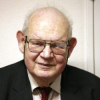Benoit Mandelbrot

Benoit Mandelbrot
Benoit B. Mandelbrot was a Polish-born, French and American mathematician with broad interests in the practical sciences, especially regarding what he labeled as "the art of roughness" of physical phenomena and "the uncontrolled element in life." He referred to himself as a "fractalist". He is recognized for his contribution to the field of fractal geometry, which included coining the word "fractal'", as well as developing a theory of "roughness and self-similarity" in nature...
NationalityFrench
ProfessionMathematician
Date of Birth20 November 1924
CountryFrance
A fractal is a way of seeing infinity.
A formula can be very simple, and create a universe of bottomless complexity.
The most important thing I have done is to combine something esoteric with a practical issue that affects many people.
Regular geometry, the geometry of Euclid, is concerned with shapes which are smooth, except perhaps for corners and lines, special lines which are singularities, but some shapes in nature are so complicated that they are equally complicated at the big scale and come closer and closer and they don't become any less complicated.
Think not of what you see, but what it took to produce what you see.
Why is geometry often described as 'cold' and 'dry?' One reason lies in its inability to describe the shape of a cloud, a mountain, a coastline, or a tree. Clouds are not spheres, mountains are not cones, coastlines are not circles, and bark is not smooth, nor does lightning travel in a straight line... Nature exhibits not simply a higher degree but an altogether different level of complexity.
Bottomless wonders spring from simple rules, which are repeated without end.
Until a few years ago, the topics in my Ph.D. were unfashionable, but they are very popular today.